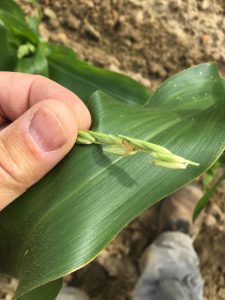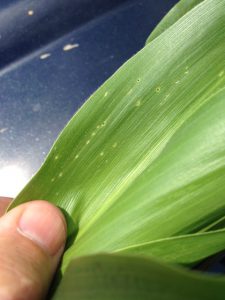Leaf mold occasionally appears in high tunnel or greenhouse tomato production in New Jersey. However, under ideal conditions the disease will develop in field-grown crops. The fungus will cause infection under prolonged periods leaf wetness and when relative humidity remains above 85%. If relative humidity is below 85% the disease will not occur. Therefore, the proper venting of high tunnels and greenhouses on a regular basis is important. The pathogen can survive (overwinter) as a saprophyte on crop debris or as sclerotia in the soil. Conidia (spores) of the fungus can also survive up to one year in the soil.
Vegetable Crops Edition
Seasonal updates and alerts on insects, diseases, and weeds impacting vegetable crops. New Jersey Commercial Vegetable Production Recommendations updates between annual publication issues are included.
Subscriptions are available via EMAIL and RSS.
Quick Links:
 NJ Commercial Vegetable Production Recommendations
NJ Commercial Vegetable Production Recommendations
 Rutgers Weather Forecasting - Meteorological Information important to commercial agriculture.
Rutgers Weather Forecasting - Meteorological Information important to commercial agriculture.
Identifying and controlling leaf mold in high tunnel & greenhouse tomato production
Controlling basil downy mildew in the field in 2023
For over a decade, basil downy mildew (BDM) has caused significant losses in basil grown in organic and conventional field and greenhouse production across the United States. At the time of its introduction, there were very few fungicides labeled for its control making it nearly impossible to grow a successful crop in many areas of the country. [Read more…]
Vegetable IPM Update 7/05/23
Sweet Corn
European corn borer (ECB) moth activity is extremely low in areas where blacklight traps are operating in the northern and central counties. Feeding in whorl and pre-tassel stage corn has increased slightly over the past week, but only in a few areas. Many plantings exhibiting no ECB injury at all. While ECB has become something of a local phenomenon in NJ, growers should not assume that feeding is below economic levels in their area.
 Look for the characteristic “shot-hole” type of feeding (photo below at right) and consider treating when infested plants exceed 12% in a 50 plant sample. As plantings proceed to the pre-tassel stage, ECB larvae may be found in emerging tassels (see photo at left). It is a good idea to treat individual plantings as they move into the full tassel/first silk stage one time. This eliminates any ECB larvae that have emerged with the tassels as they begin to move down the stalk to re-enter near developing ears.
Look for the characteristic “shot-hole” type of feeding (photo below at right) and consider treating when infested plants exceed 12% in a 50 plant sample. As plantings proceed to the pre-tassel stage, ECB larvae may be found in emerging tassels (see photo at left). It is a good idea to treat individual plantings as they move into the full tassel/first silk stage one time. This eliminates any ECB larvae that have emerged with the tassels as they begin to move down the stalk to re-enter near developing ears.
Useful insecticides for this particular application include synthetic  pyrethroids (IRAC Grp 3), spinosyns (including OMRI approved Entrust) IRAC Grp 5), and diamides such as Coragen or Vantacor (IRAC Grp 28) or materials such as Besiege which include the active ingredient in Coragen. Synthetic pyrethroids alone should NOT be used for corn earworm (CEW) protection on silking corn. Control with these materials is very inconsistent.
pyrethroids (IRAC Grp 3), spinosyns (including OMRI approved Entrust) IRAC Grp 5), and diamides such as Coragen or Vantacor (IRAC Grp 28) or materials such as Besiege which include the active ingredient in Coragen. Synthetic pyrethroids alone should NOT be used for corn earworm (CEW) protection on silking corn. Control with these materials is very inconsistent.
The highest nightly trap catches of ECB for the week ending 7/05/23 are as follows:
| Allentown 1 | Hillsborough 1 |
| Asbury 1 | Milford 1 |
| Bellemeade 1 | Lawrenceville 1 |
Phytophthora and Pythium control during wet weather
Most of New Jersey has finally gotten some significant rain after many weeks of dry weather making current conditions ideal for pathogens such as Phytophthora and Pythium. Unfortunately, Pythium cottony leak and Phytophthora blight can be found on most farms in the southern part of the state. Poor crop rotations with susceptible hosts only make matters worse. The Phytophthora pathogen has an increasing host range that now includes snap and lima beans; and all crops, other than a few resistant bell pepper cultivars, lack any resistance to the pathogen. Under ideal conditions (hot, humid, and wet) Pythium cottony leak can develop on infected fruit.
Cucurbit powdery mildew control in 2023
Cucurbit powdery mildew (CPM), caused by Podosphaera xanthii, is one the most important diseases of cucurbit crops throughout the world. The pathogen is an obligate parasite, just like cucurbit downy mildew, meaning it needs a living host in order to survive. In northern regions that have a killing frost in the fall the pathogen will die out when the crop freezes. Not being able to overwinter, the pathogen must be re-introduced each spring or summer in the mid-Atlantic region. The pathogen accomplishes this by re-infecting cucurbit crops in the spring as they are planted up the east coast starting in Florida, then the Carolina’s, Virginia, and so forth. By late May, as soon as cucurbit crops begin to germinate in the mid-Atlantic region, the potential threat for potential powdery mildew infections begin. [Read more…]
Quick reviews of fungicide chemistries, FRAC groups, and fungicide resistance management
Did you know that first EBDC fungicide was registered for use in vegetable crops in 1964 followed by chlorothalonil in 1966. Historically speaking, the first New Jersey Vegetable Production Recommendations Guide was produced in 1969 and was only 33 pages long (it’s 450 pages now). Things have changed significantly over the past 54 years when it comes to pest management! For a quick review on fungicides, FRAC groups, and managing fungicide resistance development please click on the links below.
Using tank mixes and fungicide rotations and information on FRAC group 4, FRAC group 7, and FRAC group 3 and FRAC group 11 fungicides.

